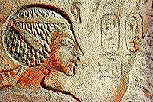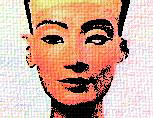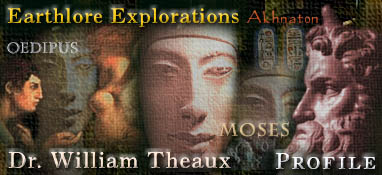|
 Dr.
William Theaux, a native of France, is a noted Psychiatrist,
Ecologist, and Founder of the doctrine of Plural Analysis. He
has spent the last 20 years investigating and revealing the mystery
surrounding the three stages of the life of Akhnaton, who lived
about 1300 BCE Dr.
William Theaux, a native of France, is a noted Psychiatrist,
Ecologist, and Founder of the doctrine of Plural Analysis. He
has spent the last 20 years investigating and revealing the mystery
surrounding the three stages of the life of Akhnaton, who lived
about 1300 BCE
 Dr.
Theaux has published several books on the subject and is respected
as an expert in this field. Dr.
Theaux has published several books on the subject and is respected
as an expert in this field.

 Dr.
Theaux's Theory of Plural Analysis' was developed as a new
technique to foster a greater connection with our environment.
It operates as a group dynamic to empower ecological progress.
It is a psychological process which looks to positive social interaction
as a precursor to constructive environmental behavior. A simple
look at ecology reveals that, at first, it is a reflection of
memory. To understand the present, we must study the past, and
so Dr. Theaux's call to the Akhnaton mystery. Dr.
Theaux's Theory of Plural Analysis' was developed as a new
technique to foster a greater connection with our environment.
It operates as a group dynamic to empower ecological progress.
It is a psychological process which looks to positive social interaction
as a precursor to constructive environmental behavior. A simple
look at ecology reveals that, at first, it is a reflection of
memory. To understand the present, we must study the past, and
so Dr. Theaux's call to the Akhnaton mystery.
AKHNATON
- The Main Characters
- AMENOPHIS III - The wealthiest
Pharaoh of Egypt and father of Akhnaton
- NEFERTITI - Famous and
beautiful Egyptian Queen and wife of Akhnaton
- TUTANKHAMON - Egyptian
Pharaoh and son of Akhnaton. His is the only preserved dynastic
tomb discovered by Egyptologists
- RAMSES II - Acclaimed
Egyptian politician and warrior who perpetuated the destruction
and erasure of all evidence and memory of the Akhnaton reign.
- MOSES - Prophet of the
Hebrews. According to the Bible, a Hebrew reared in the Royal
Court of Egypt. After killing an Egyptian soldier, he fled Egypt.
In exile, he found his calling from God. He would free his people
from slavery and deliver the laws which established God's covenant
with them.
- OEDIPUS - The mythical
son of Laius and Jocasta, who fulfills a fatalistic prophecy
by killing his father and marrying his mother. Immanuel Velikovsky
wrote "Oedipus and Akhnaton" which puts forth a compelling theory
that the Greek character Oedipus was actually Akhnaton.
- The first stage:
- Akhnaton - Pharaoh of Egypt.
- The second stage:
- Akhnaton - Prophet of the Hebrews.
- The third stage:
- Akhnaton - A founder of Athenian culture.

The Setting
 All
of these characters lived somewhere between 1400 BCE and 1200
BCE This was a most significant period in the 3,000 year Egyptian
history. A brief, but brilliant era that preceded the final decline
and fall of the Egyptian empire. All
of these characters lived somewhere between 1400 BCE and 1200
BCE This was a most significant period in the 3,000 year Egyptian
history. A brief, but brilliant era that preceded the final decline
and fall of the Egyptian empire.
 Pharaoh
Akhnaton, promoted a social-cultural revolution, and initiated
the monotheistic religion (Atonism) in Egypt. At the peak of Egypt's
power, Akhnaton reigned as an impressive creator and philosophical
renovator. He installed sweeping changes in many areas of Egyptian
society and religion. Pharaoh
Akhnaton, promoted a social-cultural revolution, and initiated
the monotheistic religion (Atonism) in Egypt. At the peak of Egypt's
power, Akhnaton reigned as an impressive creator and philosophical
renovator. He installed sweeping changes in many areas of Egyptian
society and religion.
 During
the apex of the turmoil created through these monumental changes,
Akhnaton suddenly and mysteriously disappeared. His body was never
found. This, along with the attempt by his successors to abolish
all memory and links to him, only increases the mystery. All mention
of Akhnaton was erased from Egyptian historical records and it
was forbidden to even utter his name. It was during this time
period, 1300-1350 BCE, that Moses appeared in the Sinai. During
the apex of the turmoil created through these monumental changes,
Akhnaton suddenly and mysteriously disappeared. His body was never
found. This, along with the attempt by his successors to abolish
all memory and links to him, only increases the mystery. All mention
of Akhnaton was erased from Egyptian historical records and it
was forbidden to even utter his name. It was during this time
period, 1300-1350 BCE, that Moses appeared in the Sinai.
 FREUD
wrote a book about his theory of Akhnaton and Moses. He put
forth the theory that Moses had been the disciple of, and took
religious training from a Pharaoh called Akhnaton. Freud's theory
did not rule out the possibility that Moses could have, in fact,
been Akhnaton. FREUD
wrote a book about his theory of Akhnaton and Moses. He put
forth the theory that Moses had been the disciple of, and took
religious training from a Pharaoh called Akhnaton. Freud's theory
did not rule out the possibility that Moses could have, in fact,
been Akhnaton.
 By
the middle of the 20th century, there was speculation as to
the possibility that Moses and Akhnaton were, in fact, the same
person. By
the middle of the 20th century, there was speculation as to
the possibility that Moses and Akhnaton were, in fact, the same
person.

 According
to Egyptologists, Akhnaton's mother was Queen Tiy, who was
a Hebrew, making Akhnaton a Hebrew. This is a significant element
for support of the theory of Akhnaton reappearing in the Sinai
as Moses. According
to Egyptologists, Akhnaton's mother was Queen Tiy, who was
a Hebrew, making Akhnaton a Hebrew. This is a significant element
for support of the theory of Akhnaton reappearing in the Sinai
as Moses.
 Immanuel
Velikovsky, a noted scientist, wrote of his views on the Akhnaton
Mystery. He speculated that the three plays about Oedipus that
Sophocles wrote about 400 BCE, actually described the life of
Akhnaton. This theory would have us believe that Akhnaton fled
from Egypt, made his way to the Sinai, left the Hebrews with a
scripture and laws, then fled further north to initiate Theseus,
the founder of Athens. Immanuel
Velikovsky, a noted scientist, wrote of his views on the Akhnaton
Mystery. He speculated that the three plays about Oedipus that
Sophocles wrote about 400 BCE, actually described the life of
Akhnaton. This theory would have us believe that Akhnaton fled
from Egypt, made his way to the Sinai, left the Hebrews with a
scripture and laws, then fled further north to initiate Theseus,
the founder of Athens.
 To
assimilate these ideas one must see them rejuvenating and
invigorating the future; a catalyst for a new perspective on our
future and possibly our environment. To
assimilate these ideas one must see them rejuvenating and
invigorating the future; a catalyst for a new perspective on our
future and possibly our environment.

| |
William
Theaux
Biographical Timeline
1949
Born in Paris
1960
Enters Catholic High School
1962
Begins Studying the Writings of Psychologist Sigmund Freud
1967
Enters University Majoring in Psychoanalysis
(Lacanian School)
1970
Meets F.Lefebure
1975
Receives Degree
M.D. / Paris
1979
Receives Doctorate
Ph.D. Psychiatry, Paris
1982
Establishes Practice in Lyon, France
1983
Provides Jungian Psychoanalysis
1984
Publishes the book: 'Theaux' on the psychological implications
of Artificial Intelligence
1985
Initiates the Psychological association UNEFPE;
Develops the system: 'Plural Analysis'
1986
Develops the theory: 'Akhnaton = Moses' - Expanded further to include
the parallels with Oedipus;
Develops the theory of: 'The Physiology of Meditation'
1986 - 1992
Authors fifteen books on subjects ranging from; Linguistics; Genetics;
Mass Psychology; Politics; Ecology; History (Religion, Egypt and
Psychoanalysis) and the Physio-anatomy of Libido
1988
Suffers professional and legal persecution related to public revelation
of theories
1992
Ceases practicing analysis in order to devote more time to investigating
theories, leaves post at UNEFPE, begins three years of travels
1993
Experiences a breakthrough discovery in London while researching
the lore of Hermes Trismegistus, pointing to direct identification
with the Pharaoh Akhnaton; while in London, meets with Ahmad Osman
1994
Travels to New Zealand; Speaks at the United Nations before the
SEAT organization
1995
Relocates to New York City; Establishes a forum on the Internet
to promote dialogue
on theories on the
Internet.
1997
Establishes the CYBEK Foundation for research in Genetics
dnafoundation.com
1999
Settles in Sarasota, Florida;
Authors 'The Veil' with Z. Kelper

|






